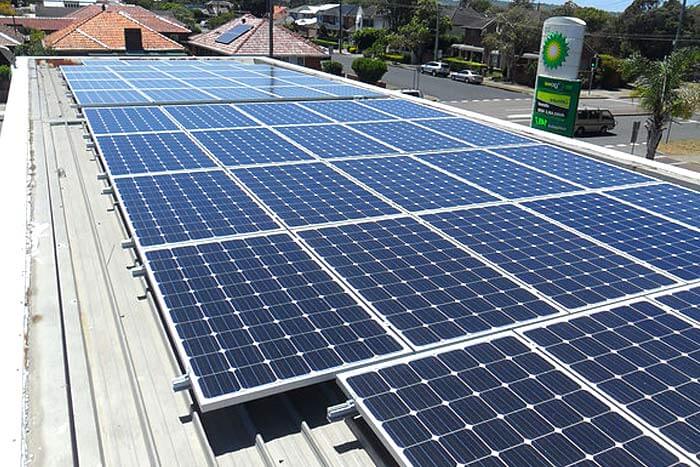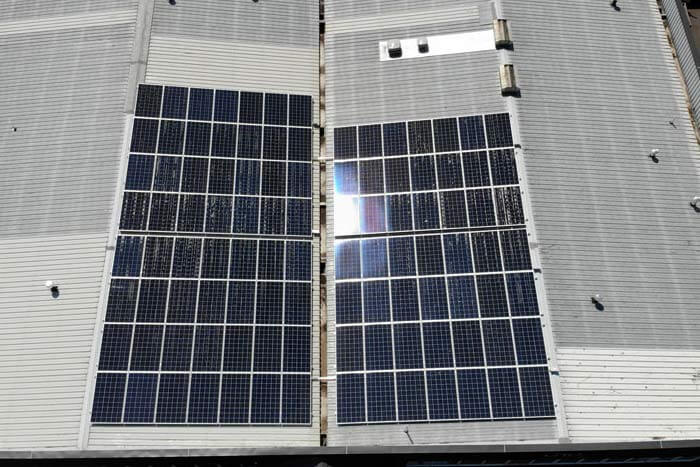Are Commercial Solar Panels Worth It?
One of the biggest emerging trends in the Australian market is the rise of commercial solar panels. Today, more and more businesses are embracing solar energy with the aim of reducing their power bills to save money.
And the truth is, commercial solar is really beneficial for the right commercial business. Unlike most homes which only use 30% of their power through the day and 70% at night, commercial businesses use 80% of their power through the day when it’s being produced.
This means that they can garner more savings in energy bills and have a faster ROI, compared to residential solar, which relies on batteries and feed-in tariffs.
Cost of commercial solar panels
The cost of solar panels has been among the biggest hindrances for many residents and commercial businesses. However, these prices have been plummeting for the better part of the decade – making the panels more affordable.
On average, commercial solar panels range from $19,994 – $80,563 inclusive of incentives and the goods and services tax. This is between $1.00 to $1.2 per kilowatt.
However, the price of these solar systems will vary depending on your location and the number of solar panels you’ll need.
Most popular sizes: 20kW, 30kW, 50kW & 100kW
| System size | Daily output | No. Panels | Avg. Cost |
|---|---|---|---|
| 20kW | 75kWh | 58 - 77 | $19,994 |
| 30kW | 114kWh | 85 - 110 | $29,735 |
| 50kW | 200kWh | 142 - 182 | $45,927 |
| 100kW | 375kWh | 286 - 400 | $80,563 |

Cost Factors that affect solar panel prices
There are several factors that will affect the cost you’ll pay for your solar panels. This includes:
- The value of the Australian Dollar – With most solar panels and equipment coming from abroad, especially Asian countries, the value of the Australian dollar in the financial markets plays a big role in determining the overall price of solar. This is why prices keep fluctuating.
- Solar rebates – The amount of incentives you receive also affects how much you’ll pay for solar panels. With some states receiving more rebates than others, your location will dictate the cost you’ll pay for solar panels.
- Market competition – Over recent years, the Australian solar market has seen a surge in the number of solar panel brands in the market. This has created a more supply than demand scenario with some panels selling at very cheap prices.
- Wholesale equipment costs – The faster manufacturers can automate their manufacturing processes, the cheaper the solar panels are becoming. Large scale manufacturing results in a lower cost per watt for solar panels, making their panels affordable to installers and customers.

Government rebates on commercial solar
As with residential solar, commercial businesses are still eligible to receive the federal government’s solar incentives under the Small-Scale Renewable Energy Scheme.
This program provides solar rebates for commercial businesses that have installed solar systems of up to 100kW to claim their Small-scale Technology Certificates (STCs).
The STCs are tradable certificates that you can exchange for discounts on your solar panels. The more certificates you have, the higher the discount you’ll receive on your solar panels.
How much rebate do commercial solar get?
As earlier mentioned, the amount of rebates you’ll receive for your commercial system depends on the number of STCs you have. To determine how many STCs you’ll receive, you need to consider two things:
- Your postal zone rating
- Size of your solar system
When introducing the rebates program, the Australian government subdivided the country into zones to make the STC distribution easier. States with higher solar intensities received higher zone ratings, earning more STCs than those with lower sun intensities.
Bigger solar systems also tend to receive more STCs since they can generate more solar power.
Here’s an estimate of the latest rebate estimate you can receive for a 30kW commercial solar system.
| State | System Size | Zone | Zone rating | Rebate |
|---|---|---|---|---|
| New South Wales | 30kW | 3 | 1.382 | $11,397 |
| Queensland | 30kW | 1 | 1.622 | $13,362 |
| South Australia | 30kW | 3 | 1.382 | $11,397 |
| Victoria | 30kW | 4 | 1.185 | $9,746 |
| Western Australia | 30kW | 3 | 1.382 | $11,397 |
| ACT | 30kW | 3 | 1.382 | $11,397 |
| Northern Territory | 30kW | 1 - 2 | 1.536 | $12,655 |
| Tasmania | 30kW | 4 | 1.185 | $9,746 |
: kW solar panels x 10-year deeming period x Zone rating X Spot STC price. (The deeming period is the time left to 2030 – when the program is completely phased out, and the spot check price used is $39.30 (average of last month)).
State government solar rebates are also available in some states, including Victoria, Queensland, NSW, and South Australia. When combined with the rebates from the federal government, these rebates cover about 50% of the total costs of commercial solar systems.
How much can I save with commercial solar panels?
It will depend on the size of the solar system you have, and how much power you consume from your solar system. The bigger the solar system, the more savings you can expect.
Similarly, the more energy your business consumes, the higher the savings you might receive. Given that most commercial businesses consume nearly 80% of their produced power, you can be sure of massive savings.
Most businesses in Australia report saving between $6,000 – $50,000 annually from their commercial solar panels.
Here’s how you can calculate a rough estimate of the expected savings from your solar system. Assuming:
- You have a 30kW solar system for your businesses (114kWh)
- Your cost of electricity is 30c/kWh
- You utilize 80% of your generated solar power
Annually, your solar system will generate: 114 x 365 = 41,610kWh. If you use 80%, you’ll have consumed: 0.8 x 41,610 = 33,288kWh.
In terms of annual savings, you’ll save around: 33,288 x 0.30 = $9,986. This is independent of feed-in tariff income if your solar system qualifies for the program.

How long until a commercial solar pays for itself?
3 – 5 years. Unlike residential solar panels, commercial solar panels tend to pay back really quickly. In around 4 years, most commercial solar panels have usually paid themselves back.
This is because of the higher energy consumption experienced in commercial businesses. Remember, the more of the generated power you use, the higher you can save and hence, the faster the ROI.
Nonetheless, the payback period for your system may be faster in some states than others. This is caused by the different costs of solar systems in different states.
Shading of any kind on your solar panels can also reduce your solar system’s efficiency and thus increase your solar system’s overall payback period.
How to calculate what size commercial system I need
The decision to go solar may be easy for commercial businesses, but determining the right solar system size for your business can be a bit harder.
With the initial cost of solar systems being very high, you can’t afford to get the wrong solar system. You, therefore, need to do your sizing right. If possible, get an expert solar installer to help you with the job, even after completing your calculations.
Here’s a guide to ensure you invest in the right solar system size.
Step 1: Determine your electricity consumption
How much power your commercial business consumes daily and monthly is the first thing you should determine. Get your annual power bills and divide by 12 for your monthly average, and then by 30, to get your daily average in kWh.
This information will help you approximate the minimum output you’ll expect from a solar system.
Step 2: Find out the sunlight intensity of your area
The amount of sunlight your area receives will determine the output of each of your solar panels. By knowing how much sunlight hours your solar panels receive, you’ll be able to choose between low-efficiency or high-efficiency solar panels, to help you maximize the output of your solar system.
You can find this information on the sun hour chart.
Step 3: Calculating the system size
With the information about your daily and monthly consumption and the sunlight hours in your area, you can now calculate the perfect commercial solar system for your business.
We will use this formula:
Solar system size = Daily energy consumption (kWh) X average consumption
Average sunlight hours
For instance, assuming your building consumes around 3500kWh monthly (117kWh daily), where you consume 80% of the generated power, and your average sunlight hours is 4.8 hours, here’s the system size you need:
= 117 X 0.8 = 20kW solar system
4.8
You’d therefore need a 20kW commercial grid-tied solar system.
You can also use a solar calculator for better accuracy on the right commercial solar system for you.
Step 4: Grid connection or battery backup
Based on the results of your calculations, you can now determine whether you’ll tie your system to the grid, or opt for a back-up solar battery. A grid connection is usually a good option for businesses that consume most of their power during the day.
You can also check with your utility company to confirm if your solar system size qualifies for net-metering. Feeding your surplus energy to the grid will improve the ROI of your solar system.
Solar battery back-ups are a good choice for businesses that would be heavily disrupted during a power blackout. It may also work for businesses that want to go completely off-grid.
Step 5: Fine-tune your installation
Once you know the solar system size and design you want, your last step is ensuring that you have enough space to fit the solar system. Solar panels in Australia are most productive facing north. So, ensure that you have enough space for north-facing panels.
If you don’t have enough roof space, consider ground mounting. This will ensure that you can get the most of the solar system you’ve chosen.
Roof space required for a commercial solar panel system.
Commercial SolarThe amount of roof space you’ll need to install a commercial solar system on your roof will largely depend on the size of panels you choose as well as the design of your roof.
The average size of a standard solar panel is 1.7m x 1m. If you choose such solar panels, you’ll need 1.7m2 for each solar panel.
Depending on the size of your solar system, you’ll need anywhere from 98.6m2 to 680m2.
However, several other factors can increase the roof space you need. This includes any equipment that’s mounted on your roof, the installation fire setback rules, and the shape of your roof.
The orientation of your roof may also demand more space as you look to tilt more panels to face North.
A good practice is to get an expert installer to assess your roof and determine the amount of roof space you need. An expert will always see whatever factors you may have missed.
FAQs
What is a commercial solar system?
A commercial solar system refers to custom solar systems designed for commercial buildings that consume numerous kilowatt-hours daily. These systems demand more solar panels than residential solar systems and generate a lot more power. Most of these systems are usually grid-tied since most businesses use their power during the day.










